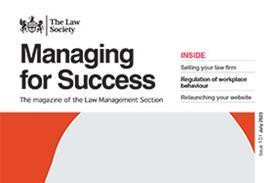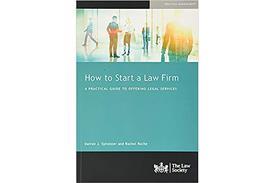David Gilmore shares five tips for improving your firm’s search engine optimisation

Ask yourself this: when was the last time you bought something through a website you found on page 2 of your Google search results? When was the last time you even clicked on this page? The truth is, we often do not bother to scroll beyond the first few links. We may not realise it, but we tend to take Google search rankings as gospel, and we only ever listen to the first verse (at most).
It is safe to say the single most effective action a law firm can take to market its services is to ensure its website is sitting at the top of the search results pages. But with thousands of firms in this country alone marketing themselves on the world wide web, how do you accomplish such a task?
1. Fine-tune your Google profile
A business’ Google page is as essential to its marketing as an Instagram profile is to an influencer. If you want your firm to be ranking higher and creating as much engagement as possible, then you need to take your Google profile seriously. You should include as much information as you can in this; the more information, the more professional a firm appears to browsers.
First and foremost, you should include a description of what your firm does. This does not need to be a sales pitch (although it can be helpful to reference your experience and reputation); the aim is to give people a clear idea of the type of work you do and the clients you deal with, so they can understand if you are the right firm for their needs.
Your profile should also include your opening hours, email address, telephone number, a link to your website, links to your social media and any reviews – whether they are from Google, Trustpilot or another online review platform.
2. Make every review count
Reviews are becoming more and more important for law firms and should be taken seriously as a marketing tool for your services. Remember, a strong collection of Google reviews is going to improve a firm’s Google business page and their overall search engine optimisation (SEO). You should therefore respond to every single review you get: the good, the bad and the ugly.
Research shows that the most trusted rating by consumers is between 4.2 and 4.5 out of 5. This doesn’t make sense – surely consumers are looking for the perfect firm, service or product? No; customers are human, and humans are imperfect, so they appreciate that businesses aren’t perfect either.
People are not looking for your firm to be flawless. What they are looking for is how you engage with your clients. This is why you must respond to every review; it shows that your firm cares about its clients: past, present and future. Furthermore, in the case of a bad review, it provides firms with the opportunity to publicly display that they can resolve issues, find common ground and make amends. You received a bad review? Great – turn it into a good one.
Browsers use online reviews as their consumerist compass. If you want to be ranking high on Google, you need to be engaging with its reviews, as well as other online review platforms such as Trustpilot and ReviewSolicitors.
3. Remember, content is king
Cash is king, as the old mantra goes. Well, today, if you want cash, you need content.
What does this mean in the context of Google SEO? Firms should be drafting and posting sufficient content on their website if they want to rank highly. The more content there is on your website, the bigger the picture Google can build of who you are, what you do and where your website belongs in the ocean of search results.
Firms should place written content on their website not just with the intention of informing those who do end up there, but to make sure people find their website in the first place. You should think about what a prospective client would search for on Google, and then weave those keywords and phrases into the content featured throughout your site.
The important thing to keep in mind with this strategy is that content is king – but only up to a point. Yes, you want to include enough content to improve your Google SEO; but include too much, and your website will become a lexical morass that no one will want to read through.
Make sure to strike the right balance.
4. Start creating short, bitesize videos
Few firms have videos featured on their website, which enables those with the gumption to create and publish video content to set themselves apart.
These videos do not need to be long. In the world of TikToks and reels, any video needs to be relatively short and, more importantly, engaging. Firms should look to place videos of no more than 60 seconds throughout their website. These videos need to add value to prospective clients in one way or another. This could be a video of key fee earners in the relevant department providing an introduction of themselves and their practice, to help build familiarity and trust, Or it could be a video explaining the current landscape of the relevant practice or sector, to help give clients context on the services they need. Whatever it is, make it short, engaging and valuable. If you are not able to produce video content, then you can opt for animation instead. (The world of artificial intelligence art awaits!)
5. Establish a catalogue of backlinks
A ‘backlink’ is a link featured on another website that brings users to your website. The more backlinks you have, the higher your website will rise in the Google algorithm’s estimations. There’s a catch, though; these must be genuine. To those entrepreneurs considering a quid-pro-quo, backlink-for-backlink scheme with their mates: this doesn’t work. If two websites have backlinks going from one to the other, Google will find these and punish the websites for it by lowering their SEO score.
Paying websites for backlinks will be punished, too. A prominent UK law firm attempted this strategy, paying a coffee shop in South America for backlinks. This worked and helped propel the firm to the top of Google searches – until Google caught up with them. Once it found out, it punished the firm by banning them from Google searches altogether for a period. The risk is not worth the reward.
Building a catalogue of genuine backlinks to your website can oftentimes be a fiendish task – but for those up to the challenge, it can be a brilliant way of improving your website’s SEO.
Conclusion
There you have it: the top five tips to improve your firm’s Google ranking. Maximising your marketing through Google is essential for your firm’s success in the digital world of today. So, get with the programme and get to the top, lest you be stuck in the forgotten oblivion of page 2 and beyond.
















